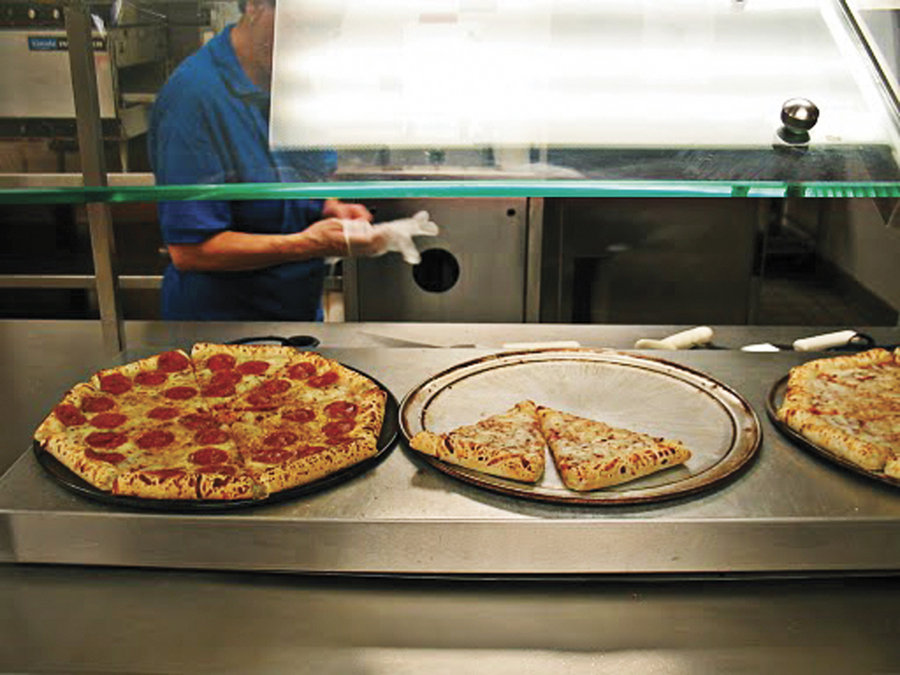You may not have fond memories of eating a school lunch, perhaps recalling a mystery meat sloppy joe, square chunks of frozen pizza, or mushy brown beans. But when the Reporter visited Secaucus Middle School during lunch period, it was evident times have changed.
It was pasta bar day. Students had the option to choose among baked ziti with mozzarella, cheese with Italian bread, real cheese or pepperoni pizza, an assortment of sandwiches, romaine greens with cherry tomatoes, fruit, and milk.
“We have baskets of apples right before the register.” – Chris Traks
____________
While fruit and vegetables were readily available, students were quick to go for the pepperoni pizza and a Snapple and bypass the apples, oranges, and bananas available at the front register.
An apple a day…
“This is part of your meal; I want you to take this,” said Christine Traks to students on line for lunch. She is the regional supervisor and operations manager for Maschio’s Food Services. The school switched to Maschio’s this year, which serves over 150 school districts throughout New Jersey.
“So many students did not want to [take the fruit]. If they don’t take the full meal then we have to charge a la carte prices,” said Traks. For $2.50 in the high school, students get five components for lunch as required by the state: protein, bread, fruit, vegetable, and milk. A la carte is $2.25.
Lunch is $2.40 in elementary schools. All the meals are prepared at the schools.
Funding more than just free lunches
Secaucus has 2,170 students enrolled in the school district. Of those, 566 get free or reduced lunches. Students on the free or reduced lunch program must take at least three out of five components in order for the school district to get reimbursed. Lunchroom servers monitor what kids take and remind them to take all five components.
The number of children in the free or reduced school lunch federal program determines how much money the district gets from the state in Title I and Title IIA funding each year: it is currently $328,000.
“Title I is really important,” said Robert Presuto, director of educational technology, data assessment, and grants. “It allows us to get additional supplemental services for kids that are underneath the Adequate Yearly Progress bar. We can get additional basic skills teachers. We can get special adaptive textbooks. That is separate from IDEA special education funding.”
Trying new approaches
“I was in Huber Street School last week and I was quite impressed with children picking up their components,” said Traks. “It is an age issue. We have baskets of apples right before the register because that will be the last thing [students] see before the cashier. We try to market it in a way that the students’ vision goes to the area.”
Traks said Maschio’s will try different approaches to get kids to eat more fruits and vegetables, such as providing nutrition education.
Diversity in food choices
The menu does provide diversity in its offerings, with items like arroz con pollo, stir fry vegetables, and chicken quesadilla.
Trak said 60 students select vegetarian meals on a daily basis. She said that more often than not, the main source of protein for vegetarians is cheese. If a student has an allergy to dairy products, he or she can make a special request, and the food service company will accommodate him or her. Maschio’s plans to add more whole grain products such as whole wheat pizza and mixes in whole wheat pasta with regular pasta so kids will eat it.
SIDEBAR
NJ has high child obesity rate
The passing of the Healthy, Hunger-Free Kids Act of 2010 introduced changes to child-nutrition programs in schools and set new standards to improve access to healthy, balanced, school lunches across the country. The bill also increased the number of students eligible for the free or reduced lunch federal program.
The legislation arose out of a need to tackle childhood obesity and hunger across the country.
Data from 2006 shows that New Jersey has the highest reported rate of obesity in the nation for low-income children ages 2 to 5. According to the Centers for Disease Control (CDC) in Atlanta, 15 percent of New Jersey youth (ninth to 12th grades) are overweight, and another 11 percent are obese, according to CDC 2005 Youth Risk Behavior Survey. Only 17 percent eat fruits and vegetables five or more times a day.
New Jersey is one of 25 states funded by the CDC to address obesity.
Nationwide, according to the CDC, approximately 17 percent (or 12.5 million) of children and adolescents aged 2 to 19 years are obese. Obesity disproportionately affects Latino and African-American children. In 2007 and 2008, Latino boys, aged 2 to 19 years, were significantly more likely to be obese than non-Latino white boys, and non-Latina black girls were significantly more likely to be obese than non-Latina white girls, according to the CDC.
Adriana Rambay Fernández may be reached at afernandez@hudsonreporter.com.
